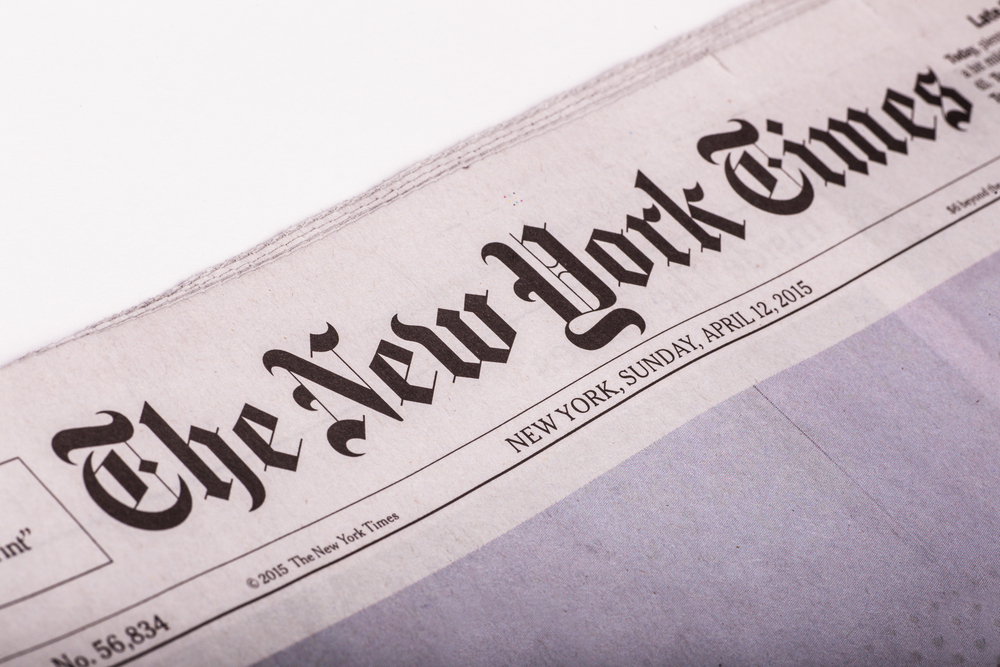That’s New York Times coverage of Israel these days: omitting critical context while attempting to impose an irrelevant and inaccurate interpretative framework.
By Ira Stoll, The Algemeiner
The news articles of the New York Times are increasingly reporting the Israeli-Arab conflict through the “Zionism is racism” framing.
Senator Daniel Patrick Moynihan once described that falsehood as the “Big Red Lie” — “the last great horror of the Hitler-Stalin era.” Back in 1991, even the New York Times editorial writers denounced it, as it had been expressed in a now-repealed United Nations resolution, as “disgraceful.”
Yet here we go again. Monday a Times news article began, “MOUNT GERIZIM, West Bank — In the occupied and largely segregated West Bank…” American readers of the paper will pick up “segregated” as a reference to pre-Brown v Board of Education schools, the separate-and-unequal Jim Crow era.
On Tuesday another Times news article, which, like the first one, carried the byline of Times Jerusalem Bureau Chief Patrick Kingsley, paraphrased Sheikh Omar al-Kiswani, director of Al Aqsa Mosque: “The de facto change in policy is just part of a larger pattern of slights against Palestinian dignity across the occupied territories, he said.”
Then came a direct quotation: “This is the prevalent reality, not only at the Aqsa Mosque, but also at checkpoints and other places in Palestine,” he said. “We face constant racist discrimination and infringement on our human rights.”
Again, the reference to “constant racist discrimination” won’t be lost on an American audience of progressive Times readers educated to be anti-racist in the wake of the police murder of George Floyd. One could say it’s just a quote, not the Times itself, but the Times chooses which quotes to use and whether to frame them with context and fact-checking cluing readers in to reality. And a pattern is a pattern.
Racism and segregation are wrong. The application of this American framework to Israel is also wrong: clumsy, misguided, and inaccurate, as are similar efforts to view Israel and the Palestinians through the lens of South Africa and apartheid. Those who apply it often do it one-sidedly; they don’t ask, for example, why it’s not “discrimination” for Ben & Jerry’s to refuse to sell ice cream to Jewish residents of the West Bank.
The second article, about Jewish prayer on the Temple Mount, has additional flaws. It says, “To many Palestinians, the shift is provocative and unfair. They feel that Muslims have already made a big concession at the Western Wall, which is now used mostly by Jewish worshipers despite its also being important to Muslims. In 1967, Israel even razed an Arab neighborhood beside the wall to create more space for Jewish prayer.”
Why was there “an Arab neighborhood” beside the wall? This Times article doesn’t explain, but the online version at least does hyperlink to a Times article from 1971 that explains: “Continuously since the Middle Ages, according to archeological evidence, the 25 acres of the Jewish Quarter inside the walls was the core of Jewish piety and Orthodox culture in King David’s holy city. There were more than 50 synagogues in this crowded space, with a population of 16,000 Jews at the turn of the century…
“The fall of the Jewish Quarter to the Arabs on May 28, 1948, ‘was the blackest event in Israel’s War of Independence,’ Mayor Teddy Kollek wrote years later. From then until 1967, the medieval synagogues and shabby dwellings of the Jewish Quarter lay in rubble from the artillery of war. Squatters began to move in. Arab families gradually came to consider the quarter their home.”
That’s not the only noteworthy omission of context. Yair Rosenberg, a senior writer at Tablet magazine, pointed out on Twitter: “Extremely weird New York Times article about Jews praying at the Temple Mount in Jerusalem that fails to note anywhere that the Temple Mount is *the holiest site in all of Judaism.* The entire story doesn’t make sense if you omit that essential fact!”
He added, “The article explicitly says that the Temple Mount/Haram al-Sharif is the third-holiest site in Islam. It was a deliberate choice to leave out the fact that it is the holiest site in Judaism. The Times ought to correct and add basic religious context to the article.”
A professor at Brandeis University and former State Department official, Yehudah Mirsky, wrote, “Everything @Yair_Rosenberg writes in this thread — about Jerusalem, journalistic practice and more — is true. And his calling the Times‘ omission here ‘extremely weird’ is, let’s say, very, very polite.”
That’s New York Times coverage of Israel these days: omitting critical context while attempting to impose an irrelevant and inaccurate interpretative framework.
Ira Stoll was managing editor of the Forward and North American editor of The Jerusalem Post.
MAKE THE LAND OF ISRAEL EVEN MORE BEAUTIFUL!
PLANT YOUR VERY OWN FRUIT TREES IN ISRAEL!
Farmers near the Gaza border lost family, friends and workers. Spring is here, and they desperately need help to replant the farms. Join us in blessing the People and Land of Israel.
“I will ordain My blessing for you…” (Leviticus 25:4)
